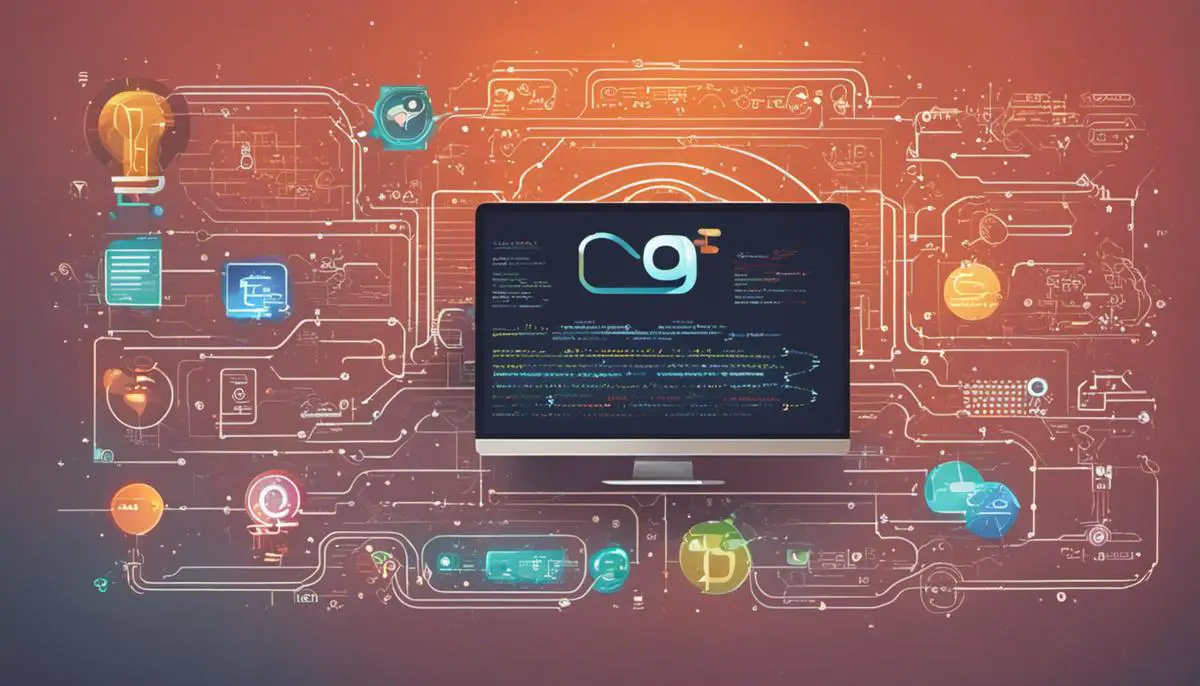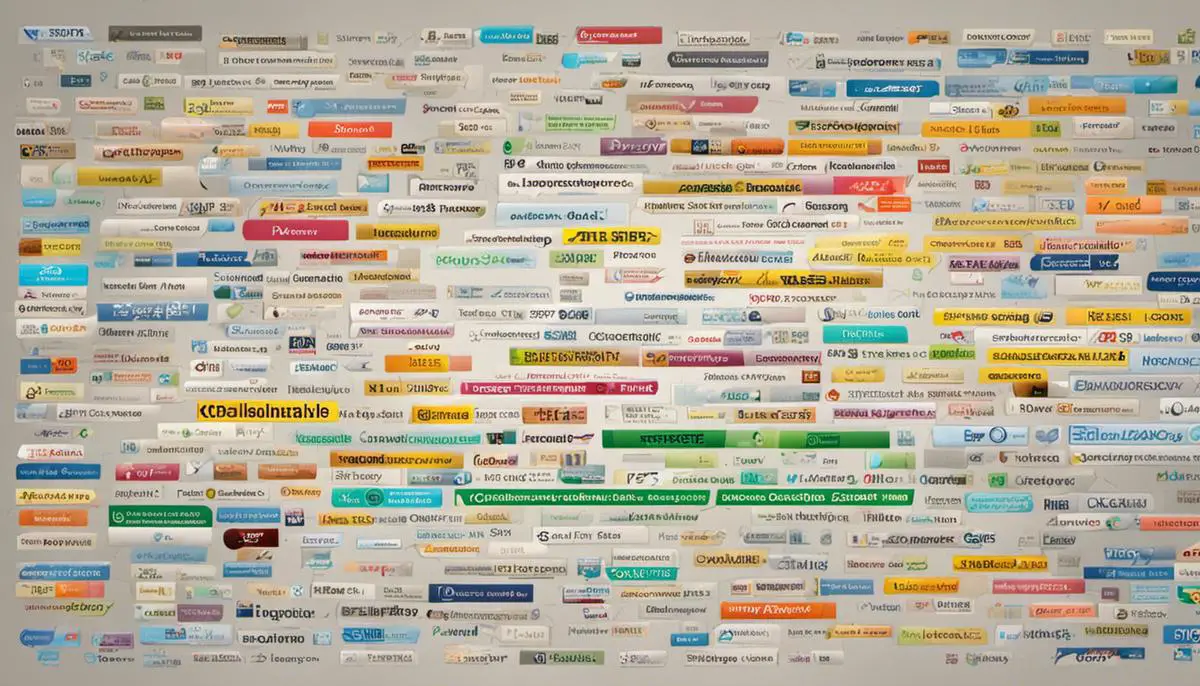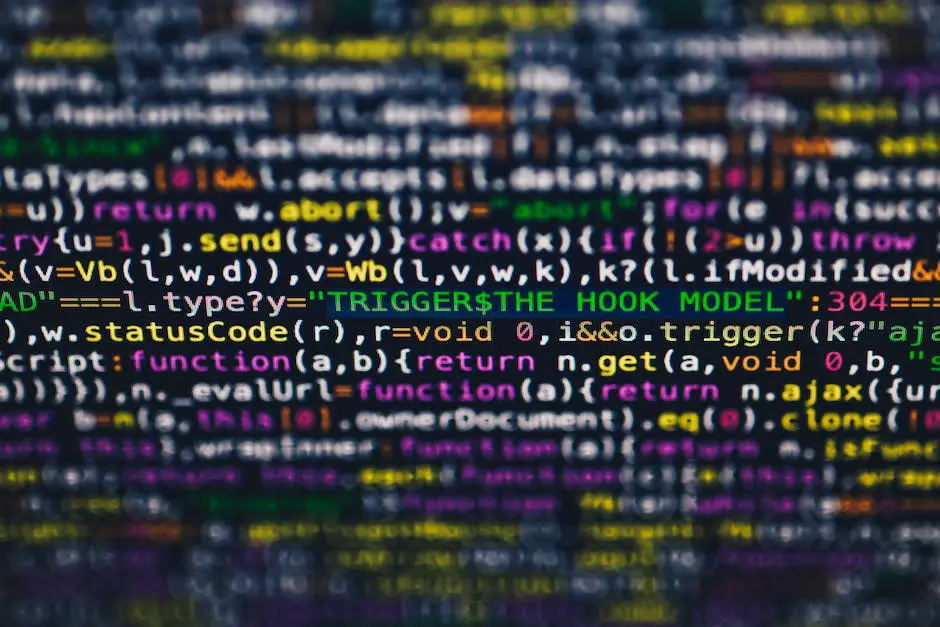In the digital era, Artificial Intelligence (AI) has become a prolific tool dramatically reshaping numerous sectors of the global economy. One intriguing application of AI lies in code translation, a computational process that is gradually becoming instrumental in streamlining tasks in the realm of software development and programming. With the prowess of AI in comprehending languages, identifying patterns, and making data-based selections, the prospects for its application in code translation are vast and growing. This examination explores such potential, critically assessing the role of AI in automating code translation, and delving into deep analyses of AI-powered code translation tools such as Facebook’s TransCoder and DeepL’s translator for programming languages.
Understanding AI and Code Translation
Artificial Intelligence and Code Translation
Artificial Intelligence (AI) involves the use of machines, systems or applications that exhibit human intelligence processes such as learning, reasoning, problem-solving, perception and language understanding. In assessing AI’s functionality in code translation, this study focuses on how AI uses its capabilities in complex pattern recognition, decision-making and language understanding to translate code from one computer programming language into another.
Fundamentals of Code Translation
Code translation, also known as source code translation or program transformation, involves the conversion of source code from one programming language (the source language) into another programming language (the target language). The need for code translation can arise due to various reasons such as modernization of software systems, migration to new platforms and languages, tailoring source code for specific execution environments and many more. Code translation can be done manually by human programmers, but in many cases, automatic tools are much more efficient, especially when dealing with large amounts of code. AI-powered code translation systems can revolutionize this process by making it faster, more efficient and more accurate.
AI Capabilities in Code Translation
With advanced pattern recognition abilities, AI can identify specific coding conventions, syntax nuances, semantics and structures of different programming languages. By understanding the patterns of the source code, it can successfully translate the code into another language while maintaining the functionality of the original code.
In addition to pattern recognition, AI’s proficiency in decision-making is critical in code translation. Code translation is not a straightforward process; it often involves making certain decisions and implementing exceptions. For example, the AI may need to determine the best way to implement a function that is available in the source language but not in the target language.
Furthermore, AI’s capability in understanding languages is essential in code translation. Just as with human languages, different programming languages have different grammar, syntax and even semantics. AI can comprehend these differences and translate the source code into the target language accurately while maintaining the original intent of the code.
Exploring Case Studies of AI in Code Translation
A prime instance of AI being used in code translation can be seen in Facebook’s own TransCoder. This AI system was designed to translate code from a certain programming language to another without the need for any form of intermediate representation or additional annotations. The technology at the core of this system is neural machine translation, similar to the technology used to translate between human languages. TransCoder has shown extreme proficiency in translating between commonly used languages such as C++, Java, and Python.
In a similar vein, IBM has come up with an AI-powered system for code translation known as IBM Mono2Micro. Its primary function is to aid enterprises in modernizing their outmoded applications by translating monolithic Java-based applications into the more current microservices structure.
The above-mentioned case studies bring to light the game-changing potential of AI in the realm of code translation. By automating this task, organizations can save time, cut down on errors, and update their software systems in a more efficient and effective manner.

The Role of AI in Automating Code Translation
The Growing Role of Artificial Intelligence in Code Translation
Code translation, the process of converting one programming language into another one, has the potential to be hugely impacted by the incorporation of Artificial Intelligence (AI). Historically, this task, also known as ‘porting’, has been carried out by seasoned programmers. Such a method can be costly, time consuming, and not immune to human error. Recent developments in AI, coupled with intricate technologies like Machine Learning (ML) and Neural Networks (NN), offer promising solutions to automate this intricate task.
Case Study: TransCoder by Facebook
One pertinent example of AI application in code translation is TransCoder, a neural transcompiler system developed by Facebook. The system utilizes unsupervised learning, which means it does not need parallel data from two different programming languages for training. It learns to translate code independently. This advance is significant as currently, there is no rich multilingual collection of translated code available for training in a supervised manner.
Facebook trained the TransCoder on more than 2.8 million open source repositories and tested it on various programming translation tasks, such as translating C++ into Python or Java into C++. The TransCoder demonstrated a high level of translation accuracy, beating out commercial rule-based systems, particularly in complex translations comprising multiple functions and APIs.
Case Study: IBM’s Project CodeNet
Another notable case study is IBM’s Project CodeNet, a large-scale, AI-powered code translation system. CodeNet is a dataset comprising 14 million code samples, covering 50 programming languages. It offers about half a million code problems, each coupled with a description, programming solution, and appropriate problem constraints.
IBM explains that Project CodeNet could serve as a benchmark dataset for building AI systems to comprehend and transcribe code. With its immense variety and volume of code samples, CodeNet encourages learning models to understand the correlations between problem description and its corresponding code, across numerous languages. This depth of learning could lead these AI systems to be capable of translating complex code, coding solutions, and maintain coherence in translated code.
Case Study: DeepL
DeepL is not strictly oriented towards code translation but is a pioneer in using AI for language translation. However, its example could be inspiring for future AI models in code translation. DeepL uses a large neural network trained on vast multilingual data, achieving translation quality that often beats human professionals and other translation services. It utilizes a unique technique called Transformer network, teaching the system to predict sentences rather than single words. The idea of applying such advanced AI and neural networks in code translation has the potential to drastically improve coherence and context-sensitivity in the translated code.
Conclusion
The case studies reviewed offer compelling insights into the immense potential of Artificial Intelligence (AI) in streamlining and enhancing the code translation process. The deployment of high-tech tools such as unsupervised Machine Learning and Neural Networks has made it possible to construct AI models proficient in interpreting, translating, and maintaining the integrity of intricate code. Looking forward, escalating progress in AI could result in the development of systems adept at translating between multiple programming languages, whilst upholding the original coding intentions and styles.

Case Study: Facebook’s TransCoder
Delving into Facebook’s TransCoder
Taking the limelight for its proficiency in performing large-scale translation assignments is Facebook’s TransCoder – an AI-driven code translation mechanism. The cornerstone of TransCoder is its core functionality as an unsupervised machine learning machine conscientious in transcribing among a variety of programming languages including Python, Java, and C++. By harnessing innovative machine learning methodologies, TransCoder empowers software developers to switch code from one programming language to another with remarkable accuracy and efficiency.
The Architecture of TransCoder
Compelling in its design, TransCoder employs a sequence-to-sequence model architecture, which is commonly used in Natural Language Processing (NLP) for tasks such as machine translation. The sequence-to-sequence model consists of an encoder and a decoder, where the encoder processes the input sequence, like a piece of Python code, into a context vector. This vector is then fed into the decoder, which turns it back into a sequence, but in a different language, for example, C++. Cross-lingual language model pretraining (XLM), an approach in which pre-training models on concatenated monolingual datasets from different languages, is the heart of TransCoder’s architecture, imparting it the ability to create accurate translations in the absence of parallel data.
AI Technologies in TransCoder
TransCoder benefits from several AI technologies, particularly NLP, to enhance its code translation capabilities. It utilizes tokenization, in which code text is separated into smaller units, or tokens, making it easier to analyze. Additionally, it uses the transformer model, a deep-learning algorithm, which intelligently captures the relationships between tokens and allows TransCoder to maintain the input code’s logic structure while translating. Beam search is another advanced AI technique employed in TransCoder for generating the best output sequence.
TransCoder’s Efficiency and Accuracy
Over the years, TransCoder has proved its efficiency by outperforming previous traditional rule-based bilingual programming language translation systems. Its architecture built on unsupervised learning techniques requires no parallel data or bilingual corpus for the models to function, making it versatile for usage across various languages. TransCoder achieves a substantially high translation accuracy, a feat established through extensive evaluation of its performance on large scale programming datasets.
Translation Capabilities of TransCoder
TransCoder exhibits superior proficiency in translating between Python, Java, and C++. Notably, it maintains the original code’s indentation, structure, and functional logic during the translation, ensuring the output code’s correctness and readability. It is also adept at handling complex translations with multiple methods, classes, and conditions, effectively translating the syntactic structure, variable names, and data types from the source code to the target language while preserving the program’s semantics.
In conclusion, Facebook’s TransCoder is revolutionizing the landscape of code translation through its advanced AI technologies and innovative architecture. This serves as a testament to the immense potential that AI holds within this rapidly expanding discipline.

Case Study: DeepL’s translator for programming languages
The Contribution of DeepL to AI-Based Code Translation
DeepL, another noteworthy AI-powered tool, has made substantial strides in the realm of language translation services. Developed by DeepL GmbH, a reputable German tech firm, its modus operandi involves the use of neural machine translation to turn codes into languages. By leveraging deep learning algorithms, it comprehends intricate language patterns and produces translations that closely mimic natural speech.
The features that DeepL brings to the table are versatile and cater to a range of applications like programming and software development. It accommodates an array of programming languages including, but not limited to, JavaScript, Python, and C++. The system cross-references codes within a document with a database populated with a plethora of programming languages. Upon activation, it promptly recognizes the lines of code and converts them into the desired language.
What sets DeepL apart is its capability to translate comprehensive documents while preserving the original format and style. This is particularly advantageous for developers dealing with bulk code files, proving to be an exceptional resource for those involved in large-scale projects or updating programming languages in established systems.
Moreover, DeepL’s intelligence extends to the understanding of context, ensuring that it translates the overall line of code instead of isolated words. As a result, it circumvents translation inaccuracies that may otherwise alter the intended functionality of the program.
DeepL’s Success in Code Translation
DeepL’s success with code translation mainly stems from its ability to provide accurate and high-quality translations. The AI program achieves this by leveraging deep learning algorithms and a vast database of diverse language patterns, allowing it to recognize and adapt to complex code structures. This subsequently helps in delivering more contextually appropriate translations compared to rule-based machine translation systems.
Moreover, the AI system’s ability to translate code lines while retaining the original format has revolutionized the way developers work. It enables them to code in their native languages and then convert the written code into universally accepted programming languages, facilitating global collaborations.
The ability to process bulk translations quickly and efficiently also contributes to DeepL’s success, providing convenience and saving time, especially for large projects that require the translation of significant amounts of code.
A Closer Look at DeepL’s Role in Code Translation
DeepL has carved out a niche in the area of AI code translation owing to its extensive features and proven successes. However, this does not absolve it of certain limitations. For instance, the ability of the machine to thoroughly understand every subtle aspect of the programming language to consistently yield effective translation outcomes is somewhat limited. This can occasionally result in errors in translation, particularly when working with intricate, specialized, or less commonly used programming languages.
In addition, the criticism concerning the over-reliance on API for the interpretation of complex data structures is noteworthy, as it may pose challenges in terms of efficiency and cost for smaller developers or programming enthusiasts.
A hot topic of debate that goes hand in hand with the use of AI-based platforms like DeepL is the issue of privacy. Notwithstanding the company’s adherence to rigorous data protection norms, the likelihood of sensitive pieces of code being exposed cannot be completely dismissed.
To sum up, DeepL’s efforts towards progressing AI code translation are commendable, but work is still ongoing in the area of mitigating its shortcomings and enhancing its accuracy and efficiency in code translation.

Future Perspectives of AI in Code Translation
The Evolution of AI in Code Translation
In the field of code translation, which entails converting one computer programming language into another, Artificial Intelligence (AI) has emerged as a crucial player. From modernizing legacy code to translating high-level languages into machine-level languages, programmers frequently utilize AI. Technological tools such as DeepCode and Codex, developed by OpenAI, employ AI-driven algorithms to scrutinize the programmer’s coded instructions and deliver a translated version in the requested language.
Case Study: Translating Legacy Code
In a world that’s increasingly reliant on digital infrastructure, legacy code poses a significant problem. These old, vast, and poorly documented source codes create security issues, hamper new developments, and require continuous maintenance. That’s where AI comes to the rescue. A team at MIT developed an AI-based system that automatically translates old code into a newer language.
For example, they were able to convert code written in COBOL, a programming language from the 50s-60s, into a more modern language, such as Python or Java. This happened through a sequence of steps, including token extraction, where individual elements were identified, then a convolutional neural network marked these tokens for conversion, and finally, the sequence-to-sequence model produced the final translation. This application of AI in code translation has promising implications for reducing the complexity associated with maintaining and updating legacy code.
Case Study: Deep Learning for Code Translation
OpenAI recently rolled out Codex, an AI-powered programming assistant. It’s a powerful tool that can generate code based on human instructions. Codex can also translate code between different programming languages. The team trained this system using Reinforcement Learning from Human Feedback (RLHF).
Their model learned to convert Python code to JavaScript (and vice versa) by comparing pairs of code snippets written in Python and JavaScript for functionally similar tasks. The AI analyzed these pairs to understand and imitate the structure, syntax, and logic of the code, subsequently enabling it to translate code between the two languages autonomously.
Future of AI in Code Translation
The future of AI in code translation looks promising yet challenging. AI models are expected to get even better at translating different programming languages, understanding the semantics, and preserving the functionality of the original code. There’s also potential for AI to not only translate code but to refactor and optimize it, making the code more efficient and clean.
On the downside, training the models requires extensive datasets, which can be difficult to acquire. Large repositories like GitHub can help, but code from these sources can often be bugged or inefficient, leading to less-than-ideal learning for the AI. Ensuring the AI correctly understands and translates semantic and syntactical nuances also poses a significant challenge.
Overall, the studies mentioned above indicate that AI can significantly accelerate the process of code translation, save resources, reduce human error, and perhaps even bring about an evolution in the field of software development. These innovative uses of AI demonstrate the potential to revolutionize coding in the future, making it more accessible and efficient.

Pushing the boundaries of what is possible with AI continues to present exciting vistas for the future. The application of these advanced and evolving technologies in code translation has been shown to enhance efficiency, reduce errors, and offer innovative solutions to complex challenges. Case studies like Facebook’s TransCoder and DeepL’s programming language translator provide promising insights into the power of AI in this area. As research in this field progresses, nascent possibilities are being uncovered that could revolutionize how software development and programming tasks are undertaken. While new horizons are being discovered, the journey also presents challenges that must be surmounted to fully harness the potentialities that AI offers. The future of AI in code translation is thus not only a testament of technological advancements but also an exploration of possibilities limited only by the extent of human imagination.
